
A larger-than-life cow statue stands sentinel over the bustling downtown bazaar in Ponta Delgada, the largest city and de facto capital of the Azores. Bovines are beloved mascots here, bedecking postcards, shot glasses, even Christmas ornaments at stalls frequented by tourists. Locals, meanwhile, snap up wheels and wedges from across the Portuguese archipelago at the pungent O Rei Dos Queijos (“The King of Cheeses”) store, adjacent to the market.
In the Azores, days start and end with dairy. There is bright yellow butter to smear on bread and fresh cow’s milk rounds served with red pepper sauce at breakfast. Dinner is often capped with sharp cheese stacked with bananas or chunks of locally grown pineapple—and port, of course. “Pretty much every day, you’re going to have cheese—it’s a given,” says Maria Lawton, a cookbook author who was born on the largest island, São Miguel, and now lives in Massachusetts.
People have been making cheese in the Azores since they first settled there in the 15th century—and though the nine volcanic islands located 900 miles off the coast of Lisbon constitute just under three percent of Portugal’s land, today they produce 50 percent of the country’s cheese and 30 percent of the country’s cow’s milk. There are two raw-milk PDO varieties, too: sharp Queijo São Jorge and buttery Queijo do Pico. Though tourism is on the rise in the Azores, many well-traveled Americans would be hard-pressed to locate the island chain on a map, and general knowledge of Azorean food and culture beyond the diaspora is woefully lacking. Over nine days last November, I visited five of the green gems—São Miguel, Terceira, São Jorge, Faial, and Pico—and a dozen creameries, both small-batch and industrial, with the Azores Business Development Society. My mission? To uncover their special and little-known dairy traditions and meet the creative makers who are bolstering the scene.
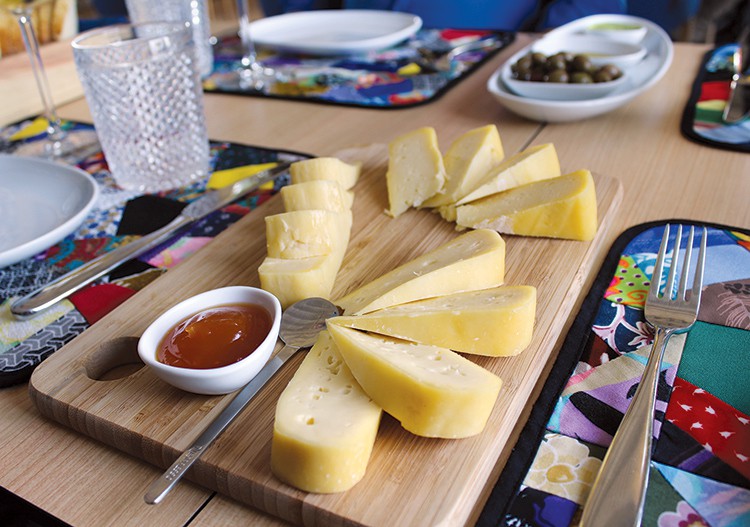
A cheese plate at Cella Bar on Pico
Home Port Advantage
Circling Terceira before our plane touches down at the tiny airport, the fog parts, revealing an undulating quilt of grass patches separated by stone walls. Grazing cows, mostly spotted Holsteins, dot dramatic cliffs. In 2014, there were 89,000 registered dairy cows in the Azores, and they are seemingly everywhere—perching on hills sloping toward the sea, lumbering down the road.
They certainly have enough to eat. Bordered by the Atlantic Ocean on all sides and influenced by the Gulf Stream, the Azorean climate is temperate and sub-tropical, with temperatures averaging between 60°F and 80°F. Persistent humidity and abundant rain feed the lush, sea-sprayed pastures where cattle munch year-round.
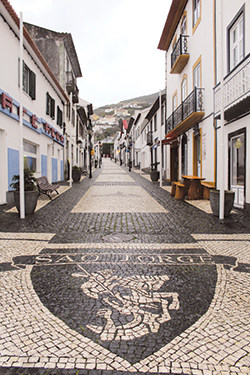
A street in Velas center on São Jorge.
“Our cows are fat here. They graze every day and some never see shelter,” says Jorge Manuel A. Costa Leite, chairman of the board at Insulac, a factory on São Miguel that produces pasteurized cheeses under the brand Valformoso. Silage is rarely used—only as a diet supplement in late fall, he says. Leite points proudly to Insulac’s vibrant yellow butter, claiming its saturated hue comes from the beta-carotene in the fresh grass.
Eduardo Vasconcelos, milk supply director at São Miguel’s Terra Nostra (owned by French conglomerate Bel), echoes these sentiments. “California can produce cheese from grass-fed cow’s milk, but the Azores is unique,” he says. To promote and help protect this terroir, Terra Nostra launched the “Happy Cows” initiative in January 2015. The 500 local farmers who provide the company with milk to create 14,000 tons of Edam-style Flamenco cheese each year submit to a series of audits and make improvements with an eye towards sustainability, animal welfare, food safety, and other benchmarks to achieve “Happy Cow” certification. So far, 34 milk suppliers have earned the distinction (plus benefits such as higher pay). “We’re ambassadors for the Azores,” Vasconcelos says.
The revered raw-milk, PDO-certified Queijo São Jorge is another important ambassador. Natives and expats alike get misty-eyed when talking about the semi-hard wheels—bursting with fresh, herbal flavors—made on the Azores’ fourth-largest island. “The feeding process of the cows here on São Jorge is one of the reasons the cheese tastes the way it does,” says Natasha Cabral, a quality manager at dairy cooperative Uniqueijo. “They eat very, very lean … the main food is grass.”
The Uniqueijo facility is large, making 1,000 tons of cheese annually, but the process is still manual, with staffers applying protective wax to the hefty rounds by hand, then scraping off any imperfections and affixing labels one by one. Cheese is made daily—twice a day when the cows are most productive between May and September.
Under PDO regulations, the cheese must be aged a minimum of three months, but the “longer it ages, the better it gets,” says Lena Amaral, another Uniqueijo quality manager. Not all Azoreans agree, however. While snackers on the Portguese mainland prefer the sharper, seven-month-aged cheese, islanders flock to creamier three-month-aged wedges. (An excellent two-year-old variety flecked with tyrosine crystals is available only at the onsite tasting room.)
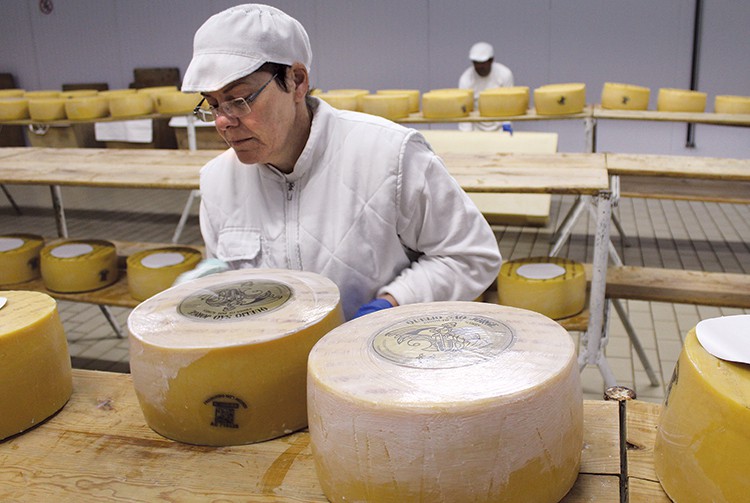
An Uniqueijo worker applies labels to wheels of PDO-certified Queijo São Jorge
Making Waves
The smaller makers I meet, however, seem to have more flexibility to experiment and innovate. On cow-scattered Terceira alone, three artisans are looking outward, celebrating and sharing dairy traditions in fresh ways.
Among them is João Henrique Melo Cota of the island’s Queijo Vaquinha. His award-winning artisan creamery turns out roughly 330 pounds of pasteurized cheese daily, six days a week, from Jersey cow’s milk (atypical in the Holstein-heavy Azores). During Cota’s childhood, his family sold milk to the factory’s original owner—and when the graying proprietor retired in 1998, Cota bought the business and the recipe for the traditional bar-shaped cheese made in wooden boxes. He’s since added large rounds aged between one and two months (including a pepper-spiked variety) and yogurts to his repertoire.
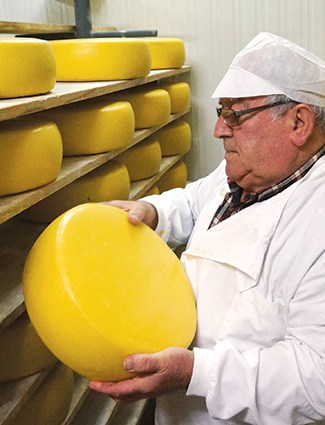
João Henrique Melo Cota moves wheels at his Queijo Vaquinha creamery on Terceira.
In 2002, Cota and his staff built a new factory and tasting room with a viewing window so visitors can witness the hands-on process unfold. “I like to work the cheese, but eventually I like to make money,” Cota says through a translator, with a laugh. Now they host events and busloads of tourists from as far away as Japan, Canada, and Cape Verde.
At family-owned Soterlac, a 15-minute drive down the road, technical director André Parreira hopes to build a tasting room and a cheese museum and aspires to go organic. In addition to fresh rounds, his factory currently crafts two aged pasteurized cow’s milk cheeses under the VB Queijos label: Ilha (aged a minimum of three months, it has a semi-hard paste dotted with eyes) and Bravo (a semi-soft cheese matured at least 45 days). His line used to include mixed-milk wheels—made with sheep’s, goat’s, and cow’s milk—but it became increasingly difficult to source the milk from the smaller ruminants. Plus, “people in the Azores aren’t open-minded when it comes to different cheeses,” Parreira says.
The company may reintroduce the cheeses as they expand to different markets, however—Parreira says he’s working on stocking shelves in Spain, Luxembourg, and Switzerland. He’s also planning a trip to California to connect with potential business partners.
Quinta dos Açores, also on Terceira, has roots in the meat business, but company manager Helga Barcelos says it was always her father Francisco’s dream to transform the milk from his herd into value-added items. In 2012, Quinta dos Açores launched yogurts and ice creams (flavors include chocolate studded with São Jorge cheese); to put the remaining 5,000 liters of daily milk to use, the company began producing pasteurized cheese in 2013. Originally trained by a mainland cheesemaker, the team now makes 150 tons of cheese in four varieties per year—including two-month-aged cow’s milk Morião, which clinched its category at the 2014 Cheeses of Portugal contest.

Quinta dos Açores cheesemakers add spices to a vat of Quinta cheese curds.
Beyond the Sea
Perhaps the cheese that’s causing the biggest stir abroad originates on sleepy Faial, the smallest of the islands we explored. There, brothers Rui and Nuno Caldeira started Queijaria O Morro in 2012, making cheese with pasteurized milk from Holstein and Simmental cows.
Thanks to advice from mainland cheesemakers and culture dealers, O Morro crafts a wheel akin to Portuguese Amanteigado and Serra de Estrela. It’s brined and bandaged during part of its two- to three-week stint in aging chambers. “We use our hands to know if the cheese is OK and to feel if it’s going in the right direction, to feel if it will be a good cheese,” Rui says.

Pepper-rubbed wheels at Queijaria O Morro on Faial.
Their objective was “to have a different cheese, a better cheese,” Rui continues, with a room- brightening smile. And it is unlike anything else I tried on my expedition: The slightly chewy rind encases an ultra-buttery paste with savory notes. Rui slices it, but you can also peel off the top and dip breadsticks into the addictive goo. The Caldeiras also make flavored twists on the flagship (garlic-and-parsley, hot pepper) and are working on an aged version as well.
Though O Morro is a young company, its original cheese is already available in the US at Portuguese shops, specialty stores, and select Whole Foods Markets. Michele Buster, vice president and co-founder of importer Forever Cheese, calls it “a jewel.” She adds: “It is good milk and made very simply. I love the mouthfeel and the balance.”
O Morro and other cheeses available outside of the islands help introduce tasters to “the nature, beauty, and clean quality of life” on the Azores, says João Moniz, an importer based in Fall River, Mass., which, along with neighboring New Bedford, is arguably the East Coast epicenter of the Azorean diaspora.
Portugalia Marketplace, also in Fall River, is reminiscent of the Ponta Delgada market and stocks a variety of cheeses. Co-owner Michael Benevides says that Americans, particularly New Englanders, are slowly discovering the Azores—and for good reason. “The people are warm, the culture is rich, and it is truly a magical place—a little treasure in the middle of the Atlantic.”
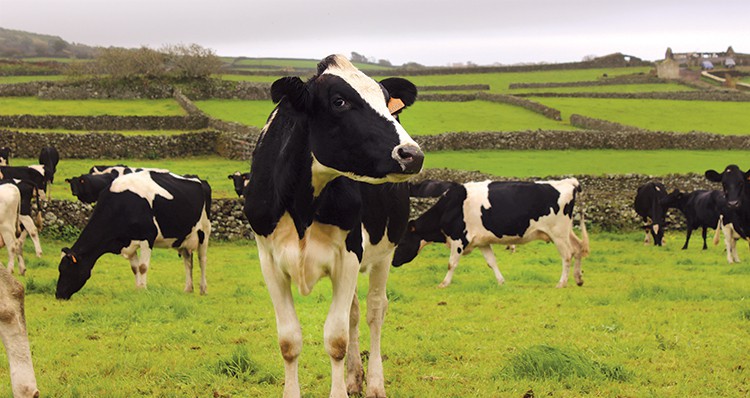
Curious cows on Terceira
EAT:
Faial
Peter Café Sport: Probably the most famous bar in the whole archipelago, this circa-1918 yachtsmen’s hang has walls papered in nautical flags and sailing ephemera. Everybody drinks tall gin-and-tonics here—order one to wash down fried horse mackerel or surf ’n’ turf.
- Rua José Azevedo “Peter” 9, 9900-027 Horta | 292 292 327
- petercafesport.com
Pico
Cella Bar: Housed in a retooled volcanic stone barn (plus a curvaceous, ultramodern timber addition), this 18-month-old spot serves homegrown wine, tender grilled octopus, and addictive pica pau—pork bits with pickles—all with a side of sweeping ocean and Mount Pico views.
- Lugar da Barca, 9950-303 Madalena | 292 623 654
- facebook.com/cellabar
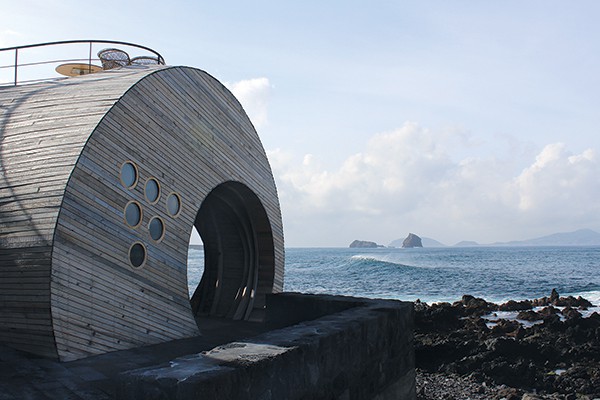
Cella Bar
São Miguel
Reserva Bar: Oenophiles should head straight to this cozy tapas bar down a dimly lit alley, where waiters suggest spot-on bottles from the Azores and the mainland’s lesser-known regions to pair with heaping platters of blood sausage, tuna belly, and, of course, cheese.
- Travessa do Aterro, N°1, Ponta Delgada | 910 543 159
- facebook.com/reserva.bar
A Tasca: Everyone seems to be having a good time at this boisterous boîte with a pretty blue-and-white facade. Do as the well-heeled locals do: Order wine and traditional snacks to share off the newsprint menu (pork sausage and fried taro; grilled limpets with hot sauce, garlic, and onions) and while away the afternoon.
- Rua do Aljube, N°16, 9500-0018 Ponta Delgada | 296 288 880
Bar Caloura: A short drive along the coast from Ponta Delgada, this smart seaside eatery is shaded by trees and specializes in simple preparations of just-caught fish such as mullet, barracuda, and tuna.
- Rua da Caloura, 20 Água de Pau, 9560 Lagoa | 296 913 283
- barcaloura.com
Fourneria São Dinis: Hoof it to this hip pizza joint on the outskirts of town and tuck into oh-so-cheesy garlic bread and wood-fired thin crust pies piled high with mushrooms, artichokes, and other super-fresh toppings. Bonus: It overlooks the Atlantic.
- Rua Padre Fernando Vieira Gomes, N°20, 9500-241 Ponta Delgada | 296 286 238
- forneriasaodinis.com
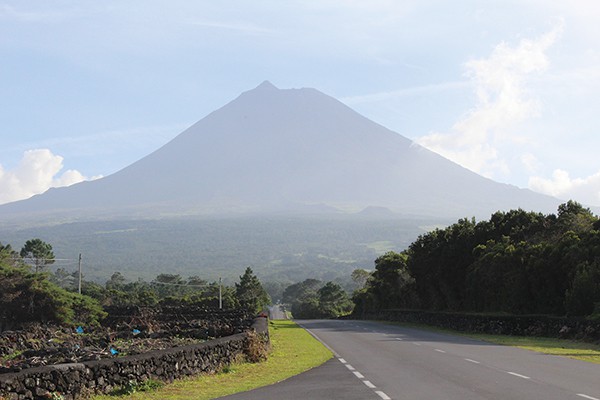
Mount Pico
DO:
Pico
Mount Pico: A taxing hike gets you to the top of 7,713-foot stratovolcano Mount Pico, the highest point in Portugal. Dramatic panoramas abound.
Wine Tasting: In 2004, UNESCO designated nearly 2,500 wine-growing acres on Pico—crisscrossed by centuries-old basalt stone walls to protect grapevines from sea winds—as a World Heritage site, calling it an “outstanding example of the adaptation of farming practices to a remote and challenging environment.” Pop into the Pico Island Wine Cooperative to try and buy the island’s protected wines, including Lajido aperitif and fruity white Frei Gigante.
- Avenida Padre Nunes da Rosa, N°29, 9950-302 Madalena | 292 622 262
- picowines.net
São Miguel
Ponta Delgada Market: Snag everything from cow-themed souvenirs and tinned fish to sweet São Miguel–grown pineapple at this airy market, open every day except Sunday. It’s also home to O Rei Dos Queijos (“The King of Cheeses”), an oft-packed shop that stocks wheels from across the Azores.
- Rua do Mercado, 9500-326 Ponta Delgada | 296 282 663
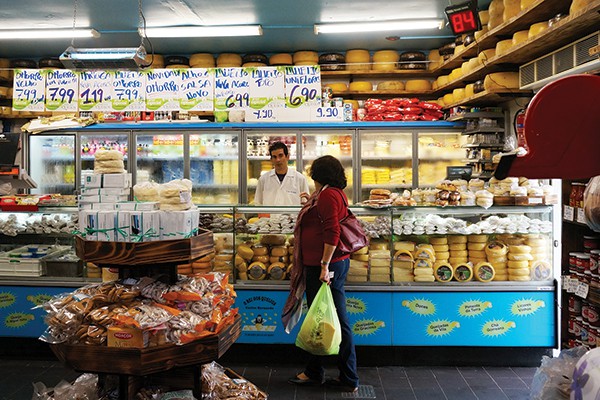
Ponta Delgada Market
Sete Cidades: Be sure to stop for pictures on the scenic roads leading down to the brightly colored twin lakes—Lagoa Azul and Lagoa Verde—in the center of this three-mile-wide volcanic crater. The sleepy hamlet on the shore, also called Sete Cidades, boasts a charming Neo-Gothic church.
Chá Gorreana: Take a tour and sip free samples at one of Europe’s two remaining tea plantations (the other, Porto Formoso, is nearby). Gorreana turns out 40 tons of tea annually and according to owner Madalena Cymbron, the aromatic Orange Pekoe variety pairs best with fresh cheeses, while the stronger Pekoe goes toe-to-toe with full-flavored São Jorge wedges.
- 9625-304 Maia | 296 442 349
- gorreana.pt
Photographed by Courtney Hollands and Kevin Donovan



